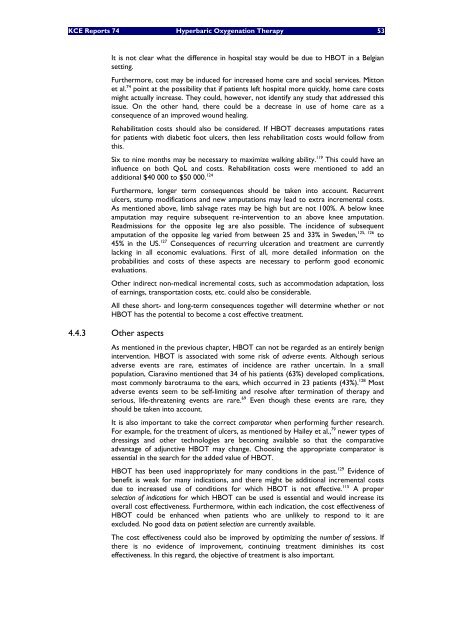Hyperbare Zuurstoftherapie: Rapid Assessment - KCE
Hyperbare Zuurstoftherapie: Rapid Assessment - KCE
Hyperbare Zuurstoftherapie: Rapid Assessment - KCE
Create successful ePaper yourself
Turn your PDF publications into a flip-book with our unique Google optimized e-Paper software.
<strong>KCE</strong> Reports 74 Hyperbaric Oxygenation Therapy 53<br />
It is not clear what the difference in hospital stay would be due to HBOT in a Belgian<br />
setting.<br />
Furthermore, cost may be induced for increased home care and social services. Mitton<br />
et al. 74 point at the possibility that if patients left hospital more quickly, home care costs<br />
might actually increase. They could, however, not identify any study that addressed this<br />
issue. On the other hand, there could be a decrease in use of home care as a<br />
consequence of an improved wound healing.<br />
Rehabilitation costs should also be considered. If HBOT decreases amputations rates<br />
for patients with diabetic foot ulcers, then less rehabilitation costs would follow from<br />
this.<br />
Six to nine months may be necessary to maximize walking ability. 119 This could have an<br />
influence on both QoL and costs. Rehabilitation costs were mentioned to add an<br />
additional $40 000 to $50 000. 124<br />
Furthermore, longer term consequences should be taken into account. Recurrent<br />
ulcers, stump modifications and new amputations may lead to extra incremental costs.<br />
As mentioned above, limb salvage rates may be high but are not 100%. A below knee<br />
amputation may require subsequent re-intervention to an above knee amputation.<br />
Readmissions for the opposite leg are also possible. The incidence of subsequent<br />
amputation of the opposite leg varied from between 25 and 33% in Sweden, 125, 126 to<br />
45% in the US. 127 Consequences of recurring ulceration and treatment are currently<br />
lacking in all economic evaluations. First of all, more detailed information on the<br />
probabilities and costs of these aspects are necessary to perform good economic<br />
evaluations.<br />
Other indirect non-medical incremental costs, such as accommodation adaptation, loss<br />
of earnings, transportation costs, etc. could also be considerable.<br />
All these short- and long-term consequences together will determine whether or not<br />
HBOT has the potential to become a cost effective treatment.<br />
4.4.3 Other aspects<br />
As mentioned in the previous chapter, HBOT can not be regarded as an entirely benign<br />
intervention. HBOT is associated with some risk of adverse events. Although serious<br />
adverse events are rare, estimates of incidence are rather uncertain. In a small<br />
population, Ciaravino mentioned that 34 of his patients (63%) developed complications,<br />
most commonly barotrauma to the ears, which occurred in 23 patients (43%). 128 Most<br />
adverse events seem to be self-limiting and resolve after termination of therapy and<br />
serious, life-threatening events are rare. 69 Even though these events are rare, they<br />
should be taken into account.<br />
It is also important to take the correct comparator when performing further research.<br />
For example, for the treatment of ulcers, as mentioned by Hailey et al., 79 newer types of<br />
dressings and other technologies are becoming available so that the comparative<br />
advantage of adjunctive HBOT may change. Choosing the appropriate comparator is<br />
essential in the search for the added value of HBOT.<br />
HBOT has been used inappropriately for many conditions in the past. 129 Evidence of<br />
benefit is weak for many indications, and there might be additional incremental costs<br />
due to increased use of conditions for which HBOT is not effective. 115 A proper<br />
selection of indications for which HBOT can be used is essential and would increase its<br />
overall cost effectiveness. Furthermore, within each indication, the cost effectiveness of<br />
HBOT could be enhanced when patients who are unlikely to respond to it are<br />
excluded. No good data on patient selection are currently available.<br />
The cost effectiveness could also be improved by optimizing the number of sessions. If<br />
there is no evidence of improvement, continuing treatment diminishes its cost<br />
effectiveness. In this regard, the objective of treatment is also important.

















